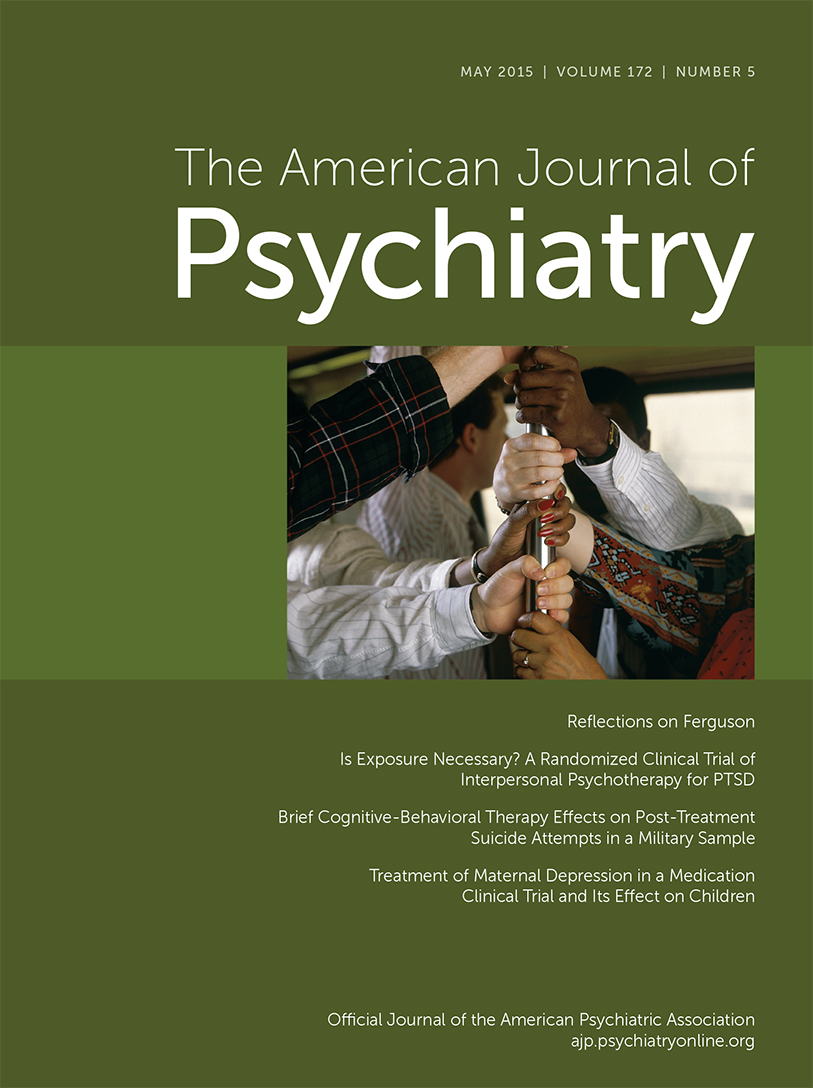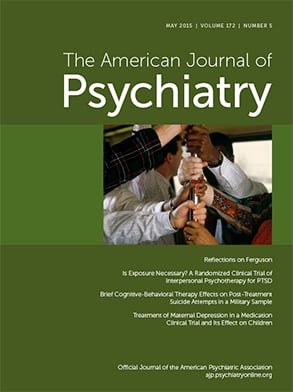Alzheimer’s disease is characterized by progressive cognitive and functional decline. There are extensive and reciprocal neuronal connections between the epicenters of emotions and cognition (
1). Thus, it is not surprising that the natural course of Alzheimer’s disease includes not only cognitive and functional symptoms but also a range of behavioral changes, alternatively referred to as behavioral and psychological symptoms in dementia or neuropsychiatric symptoms (
2–
4).
The term neuropsychiatric symptoms describes heterogeneous behavioral or mood disturbances, such as aggression, agitation, anxiety, apathy, depression, psychosis, and sleep disturbance. Neuropsychiatric symptoms are near universal among patients at all stages and etiologies of dementia, are generally multidetermined, may wax and wane, and complicate caring for patients with dementia (
2–
4). Despite the clinical impact on quality of life, behavioral, psychological, and pharmacologic therapies have proven to be inadequate to date (
5). Thus, enhancing understanding and management of neuropsychiatric symptoms is a major priority in caring for people with dementia. Effective treatments may have the potential to modify disease course, lower costs, and improve quality of life for individuals with dementia and their caregivers (
4).
Several studies have shown that neuropsychiatric symptoms are highly morbid in patients with dementia and are associated with poor outcomes, including accelerated cognitive decline and faster progression to severe dementia or death, greater functional impairment, earlier institutionalization, worse quality of life, greater emotional burden for patients and caregivers, and increased neuropathological burden (
2–
4). Neuropsychiatric symptoms are also frequently present in mild cognitive impairment and again associated with poorer outcomes, increased neuropathological burden, and faster conversion to dementia (
6,
7). Thus, neuropsychiatric symptoms appear to be a predictor of progression to dementia alongside established factors such as apolipoprotein E (APOE)-ε4 carrier status, cerebrospinal fluid amyloid-β peptide/tau ratio, amyloid imaging, MRI volumetric measurements of the hippocampal formation, and features of memory function (
7).
We struggle with multiple issues surrounding this interface. First of all, the exact mechanism of the interconnect between neuropsychiatric symptoms and cognitive impairment remains obscure. Proposed mechanisms include four possible pathways: 1) etiologic pathway, where a neuropsychiatric symptom is causing pathophysiologic changes in brain tissue that is causally linked to the development of Alzheimer’s disease pathology; 2) common neuropathological pathway: neuropsychiatric symptoms may be a direct noncognitive manifestation of the Alzheimer’s neurodegenerative disease because it affects key brain areas underlying behavior, emotion, and perception; 3) psychological reaction: a person experiencing cognitive decline may develop depression, anxiety, or similar neuropsychiatric symptoms because of awareness of gradual loss of cognitive and functional abilities; and 4) interaction: a synergistic interaction between neuropsychiatric symptoms and a biological factor leads to Alzheimer’s disease/mild cognitive impairment. These four mechanisms (and other possible mechanisms) are not mutually exclusive and may act in some sort of combinations (
4).
In this issue of the
Journal, Peters et al. (
8) report new results that advance our understanding in this important area. Using data from the Cache County Dementia Progression Study, they examine the link between neuropsychiatric symptoms in mild Alzheimer’s disease and progression to severe dementia or death. The same group of investigators previously showed that female gender, less than high school education, and at least one clinically significant neuropsychiatric symptom at baseline were predictive of shorter time to severe Alzheimer’s disease. Age at onset of dementia was predictive in that the youngest (68–80 years) and oldest (87–104 years) tertiles of age progressed to severe Alzheimer’s dementia faster than the middle tertile of age (81–86 years). In addition, patients with at least one mild or clinically significant neuropsychiatric symptom and patients with worse health were more likely to progress to severe dementia or death (
9). Expanding on that work, the authors examined the association between individual neuropsychiatric symptoms, clusters of symptoms, and progression to severe dementia or death. The Cache County Study invited all permanent residents of Cache County who were older than 65 years (N=5,677) and screened 5,092 (90%) for dementia and then reassessed them in three subsequent waves at 3- to 5-year intervals from 1995 to 2010. The Dementia Progression Study longitudinally followed those individuals who converted from no dementia to Alzheimer’s disease (N=335). Using the 10-item informant-based Neuropsychiatric Inventory, developed to assess the frequency, severity, and caregiver distress resulting from behavioral disturbances in dementia, scores were obtained at the time of diagnosis of Alzheimer’s disease and used to identify potentially predictive neuropsychiatric symptoms (
10). A dichotomous presence/absence definition was used, with presence of specific symptoms or clusters defined as a domain score >0, or frequency-by-severity composite scores were used to trichotomize all 10 domains as not present, mild symptoms (domain score 1–3), or clinically significant symptoms (domain score ≥4). Unadjusted Kaplan-Meier plots and bivariate and multivariate Cox proportional hazard models controlling for possible confounding factors (age at onset, gender, education level, APOE-ε4, dementia duration at baseline, and General Medical Health Rating) were run for association with time to severe dementia and time to death. There were 335 cases of incident Alzheimer’s disease, and of these, 68 (20%) developed severe dementia (Mini-Mental State Examination score ≤10) over the course of the study. Over the extended follow-up, 273 deaths occurred. Median time to severe Alzheimer’s disease was 8.4 years and to death was 5.7 years. Neuropsychiatric symptoms were common, with 50.9% of the sample having at least one neuropsychiatric symptom at the time of diagnosis of Alzheimer’s disease. Half of those having symptoms were rated as having mild symptoms and the other half as having clinically significant symptoms. Having psychotic symptoms (delusions and hallucinations), agitation/aggression, or at least one clinically significant neuropsychiatric symptom was predictive of earlier progression to severe dementia and death. Affective symptoms (depression, anxiety, and irritability) and at least one mild neuropsychiatric symptom were predictive of earlier death only. Worse medical health status was also associated with time to death, and age at onset showed a nonlinear relationship with time to severe dementia and a linear relationship with time to death. Neuropsychiatric symptom results were not affected by age at onset, health status, or use of antidepressants, antipsychotics, or benzodiazepines. In this study, apathy was not predictive of accelerated course of mortality, a finding in conflict with some earlier reports.
Better understanding of the role and exact relationship of neuropsychiatric symptoms to the pathophysiology and course of cognitive decline has implications regarding early identification of clinical presentations that signal higher risk of accelerated progression to severe disease or death and allows on one hand for possible modulation of the risk factors and on the other hand earlier treatment. Behavioral assessment at the time of the initial clinical dementia evaluation and at follow-up visits may be as informative regarding prognosis as cognitive assessment. As the dementia epidemic is upon us, it will be extremely important to prevent or delay progression in even some of those cases, since so much of the financial and emotional cost is realized in the more advanced stages (
11). We do not fully know yet whether treatment interventions or risk modifications are helpful in the short- or long-run—this is a grand challenge that urgently needs answers. Recent findings highlight that there is no easy solution to the treatment of neuropsychiatric symptoms in dementia (
5). Finding thoughtful, more effective, and better tolerated interventions for neuropsychiatric symptoms is a major challenge for investigators and clinicians and must become an urgent priority.

